In the world of Big Data, organizations around the world strive to make the maximum possible benefit from the data they generate. With a clean and structured way to process this data, it becomes easier to gain insights from it, which obstructs making informed decisions. The raw data needs to be cleaned, organized, and transformed into a suitable structure for the business. Data preparation tools aid in this process by providing specialized services that help developers and analysts design stable workflows, automate the process of cleaning and transforming raw data and thus help the organization make informed and smarter decisions.
In this article, let’s understand what data preparation tools are about, some key features to consider for a data preparation tool, and take a look at some of the best tools for data preparation in 2024.
Table of Contents
- What Are Data Preparation Tools?
- Key Features to Consider
- Best Data Preparation Tools
- How does Skyvia Data Integration help?
- Conclusion
What Are Data Preparation Tools?
As the name suggests, data preparation tools help users prepare and ingest raw, uncleaned data into a format useful for analysis. Often, raw data from multiple sources needs to be ingested and enriched with business features to make meaningful insights. Although it’s possible to write custom applications that help prepare your data, it comes with a cost of development and, thus, more time to market.
Data preparation tools are readymade, mostly low-code solutions with easy-to-understand user interfaces that enhance the process of preparing and cleaning data easily. Such tools are not only for technical users but also designed to cater to business users, thus empowering them to design and develop workflows.
Key Features to Consider
Whether you are using a data preparation tool or plan to use one in the future, it’s important to understand some of its key features before choosing one.
Features and Functionality
Most modern data preparation tools allow ingesting raw data from multiple sources, such as on-premise or cloud-based data stores. Additionally, integration with AI-based processing helps automate mundane tasks such as fixing column formats or typos within the text. The data that is prepared and transformed should also be deterministic, and thus, tools must have the functionality to run automated pipelines on a schedule.
Ease of Use
Data exploration and profiling are performed on the ingested data to better understand and analyze it. The easier the tool is to use, the more value it provides to the business stakeholders. Support of multi-user collaboration and version control makes the tool a suitable candidate when choosing a data preparation tool.
Customer Support
Another important factor to key in while choosing a data preparation tool is training and support. With an effective customer support plan it becomes easy for the users to overcome common challenges faced while setting up the solution or simply integrating it with existing systems. Support teams can offer access to their comprehensive knowledge base and share best practices on how to leverage the full potential of the tool. They can also help provide tailored solutions as per the business, tune performance and design optimized workflows.
Best Data Preparation Tools
In this section, let’s take a deeper look at some of the best data preparation tools on the market in 2024. While most of these have some common overlapping features, a few prominent distinctions make them stand out.
Alteryx
Alteryx is one of the leading platforms in the space of data analytics. It provides an easy-to-use interface to ingest raw data from multiple sources, clean, and transform using the Visual Workflow Designer. It’s suitable for both technical and business users to design simple and complex data transformation pipelines without the need to learn any programming language background.
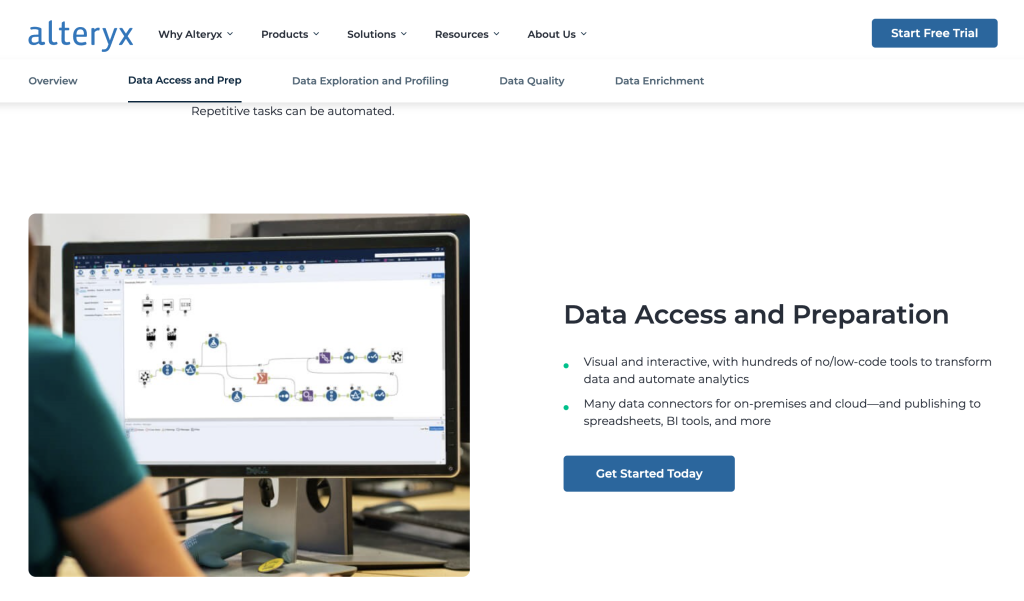
With its drag-and-drop interface, users can visually design data pipelines by integrating data from various sources and applying transformations. The final cleaned data and be transferred to an on-premise or a cloud solution of choice.
Some key features of Alteryx are as follows:
- AI-driven recommendations for data preparation and quality
- Workflow automation
- User-friendly graphical user interface
- Connections with on-premise and cloud-based storage
Tableau Prep
Tableau Prep is a self-service data preparation tool offered by the developers of the popular data visualization tool Tableau. Originally a part of the visualization tool itself, it’s now offered as a stand-alone solution for data preparation, data wrangling, and integration.

With Tableau Prep, users can connect to various data sources and ingest and clean data before visualizing them with Tableau.
Key features include:
- Strong integration with Tableau suite of products.
- Support for a wide array of data sources and sinks.
- Fast data preparation techniques
Fivetran
Fivetran is a popular cloud-based data integration tool with extensive support for data preparation and transformation. It integrates with almost every cloud-based SaaS application and datastore, making it the go-to choice for users who run their businesses on the cloud.
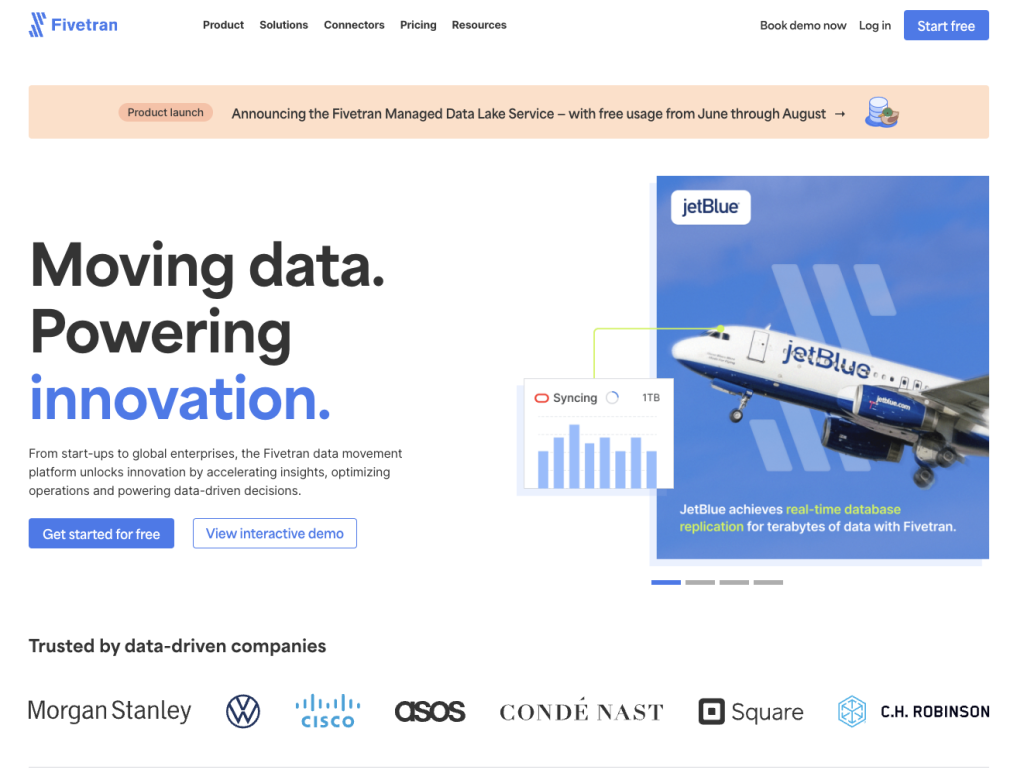
Key Features of Fivetran:
- Connectors for all major cloud vendors
- Real-time data preparation
- Sink data to Amazon Redshift or Google BigQuery for analysis
IBM Data Refinery
IBM Data Refinery is a part of a broader suite of IBM Watson Studio. With Data Refinery, users can clean, transform, and integrate raw data from sources and start exploration and profiling. Data Refinery aids in enhancing the datasets by integrating with external APIs and thus enriching the data with more business context.
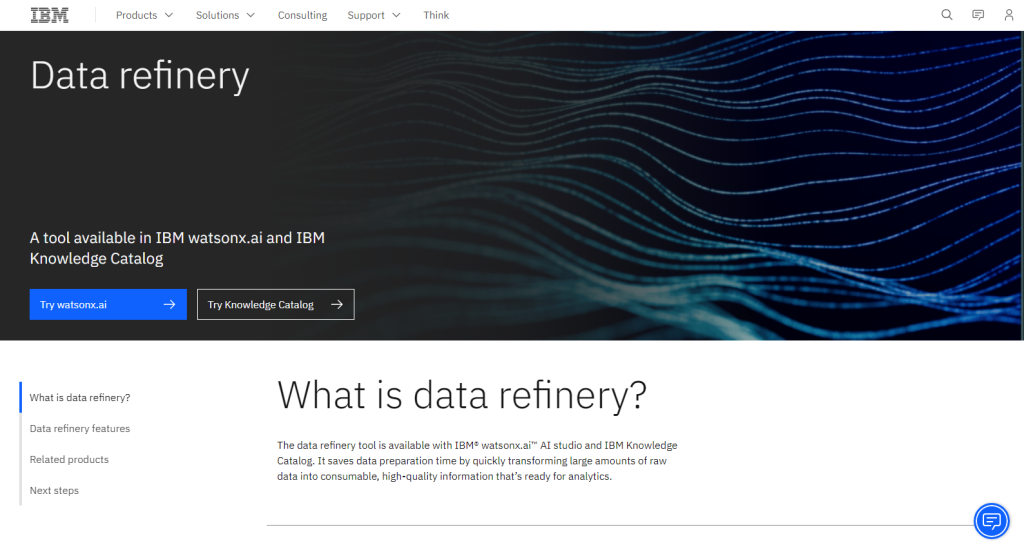
Key Features of IBM Data Refinery:
- Integration with IBM Watson and other products within the IBM ecosystem
- Cloud-based data processing for large datasets
- Built-in integrations for data security and governance
- Support for machine learning and advanced analytics
Microsoft Power Query
Microsoft has an entire ecosystem built for data ingesting, preparation, transformation, and self-service business intelligence. Within its plethora of products, Power Query is a data preparation engine developed by Microsoft that enables users to ingest and transform raw data within the Microsoft suite of products. Power Query comes inbuilt with popular tools such as Microsoft Excel and Power BI, so there isn’t a need to install it separately.
Key Features of Power Query:
- An easy-to-use interface like Microsoft Excel
- Complex transformations can be done using the M Query language
- Support for integration with Microsoft and Azure-based solutions
OpenRefine
OpenRefine, formerly known as Google Refine, is an open-source tool for cleaning and transforming messy data. It provides a user-friendly interface for exploring data, reconciling inconsistencies, and transforming data into a structured format.
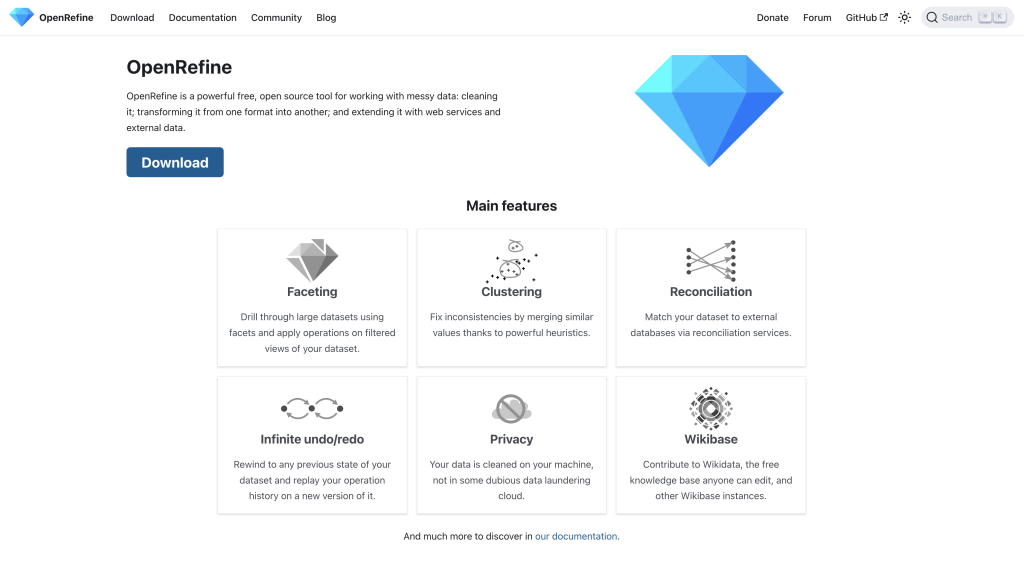
With its intelligent processing capabilities, Open Refine can detect and mitigate minor inconsistencies within the source datasets, such as removing duplicates, fixing typos, etc. There are options within the tool to split, merge, or transform datasets using pre-built or custom-designed functions. On top of these, Open Refine also provides a user-friendly interface for navigating and exploring large datasets, giving users the ability to understand the structure of their data.
Key Features include:
- Faceting and Filtering
- Data Reconciliation
- Extensibility
How does Skyvia Data Integration help?
Skyvia is one of the leading data integration providers in modern days. With its universal cloud data platform, Skyvia provides a powerful data preparation web interface that is very easy to set up and use. There are a lot of source collectors including SaaS applications from which data can be extracted and fetched.
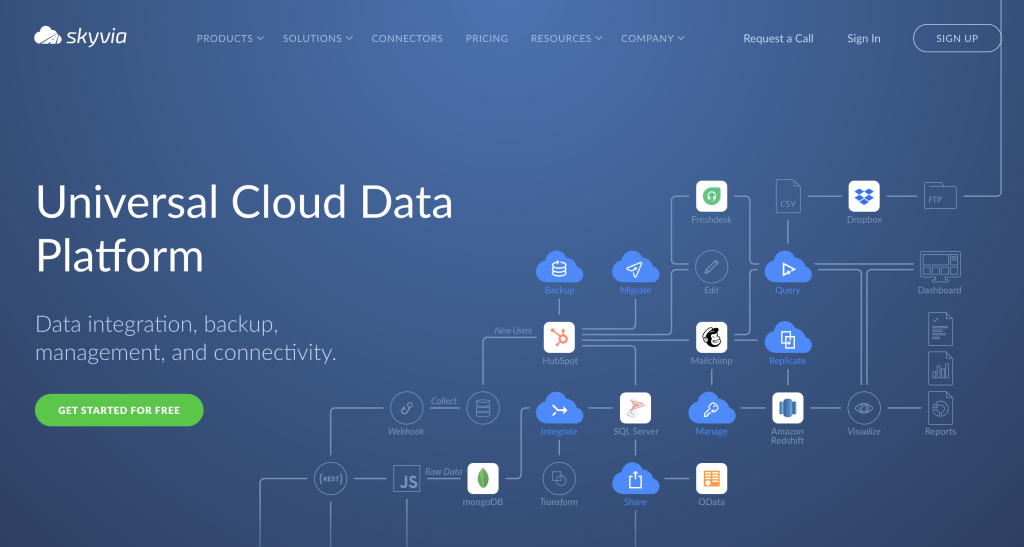
Skyvia is a market leader in providing fully functional business analytics solutions. Services range from data extraction, preparation, transformation, and finally, loading into cloud warehouses like Amazon RedShift or Google Big Query.
With a Free plan to get started, you can extract and prepare your data in a format essential for analysis and processing. However, with paid plans such as the Basic or Standard, there are a lot of options possible. They also offer a Business and Enterprise plan for heavy usage.
Advantages of Skyvia
Some of the advantages of using Skyvia Data Integration are:
- Bidirectional data integration to and from multiple source systems (DWHs, CRM tools, and SaaS applications) manually or by schedule.
- Auto mapping of columns from data sources.
- Automated backup.
- Data integration, ETL, ELT, and Reverse ETL.
Conclusion
Data preparation is an important step in data processing and business intelligence. Cleaning and preparing data before analysis yields better insights from data and thus contributes towards data-driven decision-making. Data preparation tools come to the rescue while dealing with raw, uncleaned data from source datasets.
Skyvia is a market leader in providing multiple solutions for data extraction and preparation that users can greatly benefit from. To learn more about Skyvia, please check out the product page or start it for free now!

